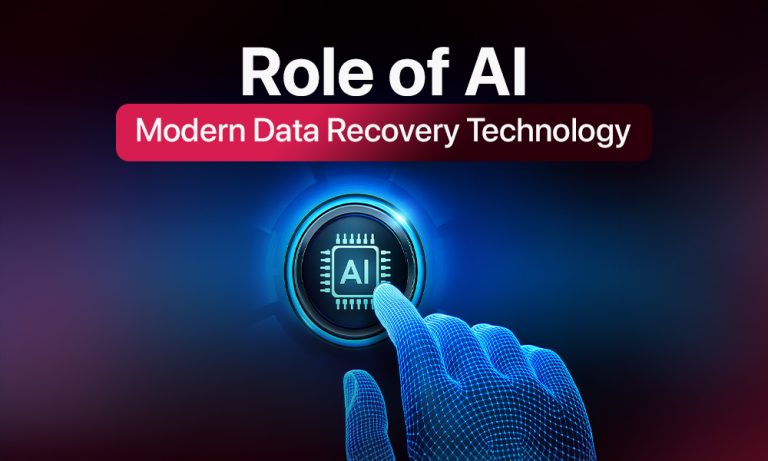Data loss can occur to anyone and while we haven’t been able to stop it from happening, the way we recover data has evolved and developed with time.
It happens to everyone: you accidentally delete something, your computer crashes, or your phone suddenly stops working. What used to be frustrating technical guesswork has become something much more accessible, only because of developments in artificial intelligence. Today, AI is making data recovery smarter, faster, and easier for everyday users.
In this blog, we’ll take a real-world look at how AI is helping people recover lost files, what makes it different from the old-school approach, and the future of AI technology.

How AI is Changing the Game
Data recovery feels like a game of chance. You run a scan, cross your fingers, and hope the file you were looking for showed up. Today, AI changes that process to make it more efficient.
Here’s how it helps:
- Faster scans: AI analyzes patterns, learns from previous recoveries, and speeds up the entire process.
- Smarter file reconstruction: If your file is missing metadata, AI can help bring it together.
- Predictive protection: AI is used to predict the early signs of any hardware failure and recommend backups.
The result is a system that’s not just reactive but proactive, and far more reliable than before.
Real-Life Scenarios Where AI Recovery Works
AI-powered recovery isn’t just for tech experts. It’s helping people in everyday situations like these:
- Your toddler deletes your vacation photos. Even if files were partially overwritten, AI can identify the file structure and bring them back.
- Your laptop crashes mid-presentation. Documents that would’ve been lost forever five years ago can now be reconstructed, often with formatting intact.
- Your phone gets infected with malware. AI-based tools can help recover not just media files but also texts, contacts, and app data.
- Your external drive won’t mount anymore. Even if the drive is unreadable, AI can scan sectors directly and pull out what’s salvageable.
From corrupted email files to damaged video projects, today’s tools aren’t just powerful, they’re surprisingly user-friendly.
What Makes AI Recovery Tools Better
Let’s break it down: how AI recovery tools shine in comparison to the other traditional methods you might be familiar with:
- Scan speed: AI tools work faster by recognizing patterns. Traditional tools take more time as they scan most things manually.
- Recovery accuracy: AI tools can recover more data, even if files are damaged or incomplete. Traditional tools often miss files without perfect data.
- Ease of use: AI software guides you through recovery with a clean interface. Traditional tools require technical knowledge and trial-and-error.
- File format support: AI tools support thousands of formats, including photos, videos, and proprietary software types. Older tools are limited to basic formats.
- Proactive features: Some AI tools can detect failing hardware and suggest backups before a crash. Traditional tools only respond after data loss occurs.
Top AI-Powered Recovery Apps to Try
Here are three leading options available in 2025:
- Stellar Data Recovery: A powerful tool with deep-scan AI, file previews, and support for encrypted and RAID drives. Great for personal and professional use.
- Wondershare Recoverit: Known for its intuitive UI, this app uses AI to recover video files, formatted drives, and even partially damaged data. Ideal for creatives.
- EaseUS AI Mode: Their latest update introduces AI-assisted recovery suggestions and smart scanning. Beginner-friendly and very responsive.
AI Tools at a Glance
| Feature | Stellar | Wondershare Recoverit | EaseUS AI Mode |
| Scan Speed | Fast | Very Fast | Fast |
| Success Rate | High (esp. with deep scans) | Moderate to High | High |
| User Experience | Beginner + Pro friendly | Very beginner-friendly | Clean & simple |
| Pricing | Free up to 1GB, Paid tiers | Paid with free trial | Free trial + Paid |
| Advanced Features | RAID, encrypted drives, disk imaging | Video repair, AI photo recovery | AI auto-detection, system backup alerts |
How to Use AI Recovery Software the Smart Way
Regardless of the tool you choose, these best practices can help you get the best results:
- Act fast. The longer you wait, the more likely your lost files will be overwritten.
- Don’t install recovery software on the same drive where you lost files. Use a separate drive or USB.
- Preview first. Most AI tools show previews so you can decide what’s worth recovering.
- Set up automatic backups. Many AI tools now suggest or offer automatic backups. Let them.
- Create a disk image if your drive is failing. This helps you avoid scanning the damaged drive again and again.

Looking Ahead: The Future of AI in Recovery
What’s next? AI isn’t stopping here. The future of recovery is already taking shape with new features like:
- Real-time protection: These features are included in tools that monitor behavior and warn you before data loss even happens. According to a 2024 IDC report, by 2026, over 70% of enterprise backup systems will incorporate AI or machine learning to automate threat detection and response. [Source]
- Cloud integration: Automatic restoration from the cloud after accidental deletions.
- Predictive analytics: Your system might soon tell you it’s about to fail and suggest a backup on the spot. Gartner predicts that by 2027, AI-driven anomaly detection in backup processes will reduce data loss incidents by up to 90% compared to traditional systems. [Source]
- Voice-based recovery: Imagine asking your assistant, “Recover my deleted spreadsheet from yesterday,” and getting it back in seconds.
The future of data recovery isn’t just about finding what’s lost. It’s about never losing it in the first place.
AI Makes Data Recovery Easy
There was a time when data loss meant panic, but AI is changing that story.
Today, data recovery doesn’t require tech skills, time-consuming scans, or hoping for a miracle. Just a few clicks and your files are back.
From fast scanning to file previews and smart alerts, AI gives you confidence. So whether it’s photos from your last holiday or that big client deck, don’t worry. AI data recovery has got you.


